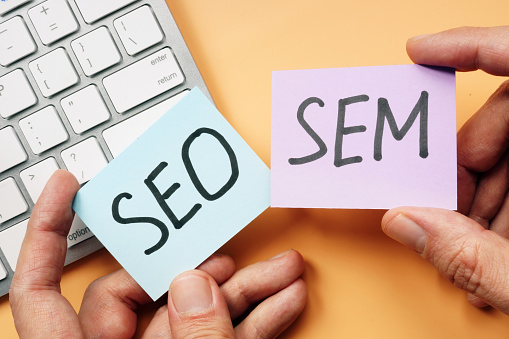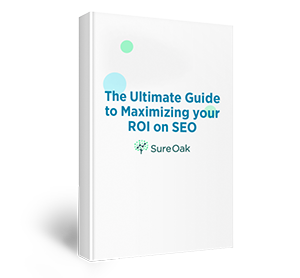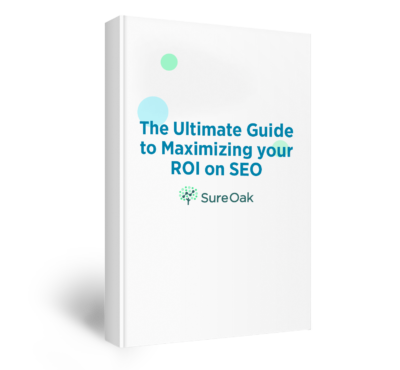The world of digital marketing is filled with often confusing acronyms. You’ve probably heard of the terms SEO and SEM, but you might not be sure exactly what they are and how they differ. You might also be wondering if one is better than the other. In this article, we’ll go over what SEO and SEM are, how they differ, and how you can integrate each into your company’s digital marketing strategy. Let’s start with SEO.
What is SEO?
Search engine optimization (SEO) refers to a set of best practices to enhance ranking on search engine results pages (SERPs). Digital marketers create bespoke SEO content by carefully examining popular Google search terms. Once they’ve identified a target word or phrase, they can build a blog post, webpage, or another piece of online content around that keyword.
While SEO has long been identified with written content such as blog posts, it encompasses a variety of online information-sharing mediums. For example, the increasing popularity of voice SEO has seen an explosion in that content form. Ultimately, SEO is about driving organic web traffic to a certain website or a specific webpage.
What is the Main Objective of SEO?
The purpose of SEO is to increase the visibility of a website and increase organic traffic. Often, companies will pursue an SEO strategy as part of their overall marketing plan. Additionally, marketers can use SEO to touch on different aspects of the purchase funnel. For example, an informational blog post with SEO characteristics may help to increase brand awareness.
Types of SEO
Internet marketers use different terms to refer to various types of SEO practices. Blackhat SEO, for example, refers to unscrupulous SEO practices, such as paying a spam website to host backlinks to your website. Whitehat SEO describes actions considered above board. Meanwhile, if you’re trying to rank highly for your town or location, you’re engaging in local SEO.

Generally speaking, there are three main types of SEO. Understanding each class will allow you to optimize your website to rank highly on SERPs fully.
- On-page SEO is what most people think of when they talk about SEO. On-page SEO involves tailoring your website’s content to match what the major search engines are looking for. Common on-page practices include following proper formatting, keyword usage, bullet point lists, bite-sized information chunks, meta descriptions, headers, infographics, and pictures. If you’re looking to refine your approach or need guidance, an on-page SEO consultant can be invaluable.
- Off-page SEO refers to anything outside of your website that influences your website’s SERP ranking. Off-page SEO has become somewhat synonymous with backlinks. However, social signals such as Facebook shares, retweets, and influencer marketing can all be grouped under this umbrella.
- Technical SEO describes the way your website is set up. Search engines favor websites with an intuitive interface. Copious internal linking and a flat hierarchical structure help site users and Google crawlers navigate your website.
What are the Benefits of SEO?
Why is SEO important? SEO is a fantastic long-term strategy to drive organic traffic to a website. Though it can take a while to get the ball rolling, once your website begins to rank high on Google’s SERP, keeping it there requires comparatively little effort. You can compare SEO to an avalanche. It might start small, but as you continue to regularly update your site with new content, the benefits will accrue more quickly.
That’s because most internet users rarely stray beyond Google’s first page of search results. Even within the first page, traffic increases exponentially as you travel up the results ranking. Greater website traffic can lead to heightened brand awareness, more sales, greater website ad revenue, and more e-mail newsletter sign-ups. Positioning yourself near the top of Google’s rankings for a given search term may cause readers to regard you as a subject matter authority.
What is SEM?
What is SEM in marketing? Search engine marketing (SEM) is a catch-all term used to describe digital advertising that connects consumers to online purchases. Both unpaid forms of digital marketing, such as SEO strategies, and paid forms of digital marketing, such as pay-per-click (PPC) marketing, are commonly included under the SEM umbrella.
If you asked multiple digital marketers what the differences are between SEO and SEM, you might hear from some that SEO is a subset of SEM. However, other digital marketers insist that SEM only comprises paid, digital advertising strategies. For our purposes, we’ll focus primarily on inorganic or paid SEM strategies in this section.
Other, less-common forms of SEM include ad campaigns that charge per impression rather than per click. These campaigns focus on building brand awareness, whereas PPC campaigns emphasize conversions and sales performance.
What are the Main Objectives of SEM?
SEM exists to get your ad in front of consumers. Marketers use SEM strategies to reach consumers at different points in the customer journey. For example, an impression-based campaign can help you raise brand awareness. You can use other forms of SEM, like retargeting ads, to convert warm leads into customers.
The primary advantage of SEM over traditional forms of advertising is the granularity of your approach. While television, radio, and print newspaper advertisements relied on mass outreach, SEM marketing lets you target only those individuals who’ve expressed an interest in your keywords. Google and other search engines use keywords to match your advertisements with the right searchers.
This increases the likelihood that your advertisement will convert into a sale. SEM enhances digital marketing efficiency by increasing the likelihood that your ad gets served to warm leads. This is one of the greatest benefits of search engine marketing.
Types of SEM
PPC is the most common form of SEM. We’ll explore this advertising model in more depth later on. For now, we can note that PPC encompasses most digital advertising models. With PPC, you select one or more keywords and bid a certain amount of money on each keyword. If you win the keyword auction, your ad will be served. With PPC, you only get charged when someone clicks on your ad.
Geotargeting ads allow you to optimize search engine marketing by targeting individuals within a certain geographic area. Meanwhile, retargeting lets you focus on internet search users who’ve already visited your website. Since it generally takes multiple touches before a consumer makes a purchase, retargeting ads tend to have higher conversion rates than other ad types.
Mobile search advertising lets you target smartphone users. With over half of all internet search traffic coming from mobile devices, few digital marketers can afford to ignore this form of SEM.
What are the Benefits of SEM?
When looking at paid search versus SEO, it’s important to note that paid advertisement campaigns will get quicker results than SEO strategies. You can get most advertising platforms to start servicing your ads on the same day that you launch your campaign. You can choose to only serve your ads to internet searchers located in a specific area.
Performance-based ad types like PPC ads ensure that you only get charged if the ad successfully drives traffic to your website. This can help you avoid wasting money on ineffective advertising practices. SEM for small businesses works well because of the low budgeting thresholds for engaging in PPC campaigns on most major platforms.
With advances in machine learning, setting up and monitoring SEM campaigns won’t require loads of time. Major advertising platforms have steadily improved their auto-targeting campaigns. Platforms like Google and Amazon aren’t just looking at your bid amount. They want to connect consumers to the right advertisement, even if it means awarding the advertising impression to a lower bidder. That means you’re more likely to connect with the people who will most benefit from your ad.
What is the Difference Between SEO and SEM?
Some people will classify SEO as a subset of SEM. While SEO definitely falls under the digital marketing umbrella, rapid growth in the field of SEO has led many marketers to treat it as a distinct discipline.

How are SEO and SEM Similar?
Both SEO and SEM make use of search engine algorithms to connect websites to their target audience. Although SEO relies on organic traffic and SEM uses paid traffic, both make use of keywords to match up websites and specific web pages to common search queries. Let’s say that you own a pet food store in Shaker Heights, a suburb of Cleveland.
You might launch a Google Ads campaign targeting keywords like “Shaker Heights pet food”, “best dog food Cleveland”, and “cat food Shaker Heights”. You can use keyword mining tools to get a sense of what sort of words and phrases internet users search for. Meanwhile, you could also optimize your online sales page, blog, and location page with the same or similar keywords. When someone searches for one of your targeted keywords, they’ll find your ads at the very top of the SERP and relevant web pages from your website not far below.
SEO & SEM vs. PPC – How is PPC Different?
PPC advertising often gets classed under the SEM umbrella. PPC refers to a common form of digital advertising used by various online platforms, including Google, Facebook, Amazon, and YouTube. In a PPC campaign, you’ll commonly select a series of keywords to bid on. Going back to our pet food example, you might choose keywords such as “Shaker Heights pet food” and “best dog food Cleveland”.
Then you’ll set up a cost-per-click (CPC) bid. This is the maximum amount of money that you’re willing to pay for a single click. Most advertising platforms will let you individually tweak your CPC for each keyword. They may also provide a suggested bid range. You will also set a budget for your campaign. Many platforms, including Google and Meta ads, allow you to start at just $5 a day, making PPC an affordable advertising entry point for small business owners.
PPC ads generally work as a sort of online auction. In addition to your CPC price, advertising platforms use machine learning tools to determine the best fit for specific keyword slots. If you bid $0.36 for “best dog food Cleveland” and an Australian company bid $0.56 for the same keyword, Google would likely display your ad to people within the Cleveland, Ohio area and the Australian ad to internet searchers located in or near Cleveland, Queensland (yes, there’s a city named Cleveland in Australia!).
Although Google could’ve made more money serving the Australian company’s ad, it would rather serve the right ads to the right people. Poorly placed ads don’t convert well. Irrelevant advertising can damage relationships both with internet searchers and advertisers alike.
Many PPC platforms will not charge your exact bid price. Instead, they’ll charge you the next highest bid price plus a penny. Consequently, if you bid $0.36 and the next highest bid was $0.33, then you’ll pay $0.34. On your next PPC campaign, try using odd numbers for your bids. If the competition bids $0.40, then you want to bid $0.41.
PPC ads often contain keywords within the ad copy. That’s where the similarities with SEO end. The biggest difference between PPC advertising and SEO content is that the former requires continuous spending while the latter drives organic search traffic at no cost to you. PPC ads also tend to be shorter than SEO content. Many SEO blog posts stretch between 1,500 and 2,000 words, while PPC ads are often limited to a few lines.
SEO content strategies tend to be subtle, overarching, and strategic. An SEO blog post may relate only tangentially to your company’s product or service. These posts serve to build brand awareness and authority. Meanwhile, PPC advertising campaigns are laser-focused on profitably converting internet searchers into paying customers. In other words, marketers tend to use SEO as a top-of-the-funnel strategy, while PPC ads operate at the bottom of the sales funnel.
SEM vs. SEO FAQs
What is Local SEO?
Local SEO refers to an SEO strategy that seeks a high-ranking relative to other websites targeting your local area. Location-based businesses tend to favor local SEO. If you own a brick-and-mortar store, or if you offer any in-person services, such as a dog-walking or power-washing business, using local SEO will connect you with customers in your area.
Local SEO makes use of location-based keywords. If you own a law firm and you’re embarking on a local SEO strategy, you’ll want to use keywords like “best lawyer in Akron”, “Akron lawsuit help”, and “top attorneys in Akron, Ohio” to enhance your online visibility, a goal achievable through Sure Oak’s tailored local SEO services.
What is Technical SEO?
Technical SEO has nothing to do with keywords or backlinks. Rather, it refers to your website’s performance and architecture. Google and other major search engines have expressed a preference for websites with fast load times. You can measure your website’s load speed using a free tool provided by Google.
Website architecture describes the way your website is set up. Google favors websites with copious amounts of internal linking and a flat organizational hierarchy. Internal links help users and Google crawl bots easily navigate your website. Crawl bots or crawlers are the programs that Google uses to index websites. If your website isn’t indexed, it won’t appear on a Google search. If a certain page within your website isn’t accessible via linking or your website’s internal navigation, it runs the risk of not being indexed in Google.
A flat organizational hierarchy means that all of your web pages are easily accessible from your website’s home page. Aim for no fewer than four degrees of separation between any given webpage and your homepage. Any more than that, and you run the risk of being penalized.
What is an SEO Strategy?
Your SEO strategy is a high-level strategy that determines what sort of content you publish and how frequently it gets published. Your SEO strategy should take into account your SEO goals, target audience, resources, competition, and niche. Businesses with greater resources may attempt to dominate more heavily trafficked search terms, while smaller businesses will focus on niche areas.
Some websites will create content clusters or several interconnected articles all dealing with the same subject matter. Search engines such as Google favor the use of content clusters. Consumers may also view content clusters as evidence of subject matter expertise.
Does a Business Need Both an SEO Strategy and an SEM Strategy?
Yes, businesses should view SEO strategies and SEM strategies as complementary. Each enhances the other. For example, targeting the same keywords with a Google Ads campaign and an SEO content cluster can help your website receive more traffic. SEM ad campaigns also tend to get off the ground quickly, while SEO strategies take more time to achieve measurable results. However, SEO strategies often prove more cost-effective over the long run.
SEO and SEM strategies may interact with consumers at different points in the sales funnel. SEO content can help you build brand awareness. Meanwhile, a digital ad retargeting campaign can help you reach those same searchers later on. The rule of seven states that it takes seven touchpoints before a consumer will make a purchase. Using SEO and SEM in conjunction can help you get there.
You shouldn’t look at search engine optimization versus search engine marketing as an either-or situation. Embrace both for the most impactful results for your business.





